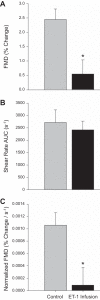Vascular function and endothelin-1: tipping the balance between vasodilation and vasoconstriction
- PMID: 27909229
- PMCID: PMC5338602
- DOI: 10.1152/japplphysiol.00772.2016
Vascular function and endothelin-1: tipping the balance between vasodilation and vasoconstriction
Abstract
Endothelin-1 (ET-1), a potent vasoconstrictor secreted by vascular endothelial cells, has been implicated in the pathophysiology of numerous cardiovascular diseases, yet the direct impact of ET-1 on vascular function remains unclear. Therefore, in seven young (23 ± 1 yr) healthy subjects, we investigated the effect of an intra-arterial infusion of ET-1 on reactive hyperemia (RH) and flow-mediated dilation (FMD) in the popliteal artery following 5 min of suprasystolic cuff occlusion. ET-1 infusion significantly attenuated basal leg blood flow (control: 62 ± 4 ml/min, ET-1: 47 ± 9 ml/min), RH [area-under-curve (AUC); control: 162 ± 15 ml, ET-1: 104 ± 16 ml], and peak RH (control: 572 ± 51 ml/min, ET-1: 412 ± 32 ml/min) (P < 0.05). Administration of ET-1 also reduced FMD (control: 2.4 ± 0.3%, ET-1: 0.5 ± 0.5%) and FMD normalized for shear rate (control: 10.5 × 10-4 ± 2.0 × 10-4%/s-1, ET-1: 0.9 × 10-4 ± 2.8 ×10-4%/s-1). These findings reveal that elevated levels of ET-1 have a significant impact on vascular function, indicating that studies employing RH and FMD as markers of microvascular function and nitric oxide bioavailability, respectively, should exercise caution, as ET-1 can impact these assessments by tipping the balance between vasodilation and vasoconstriction, in favor of the latter.NEW & NOTEWORTHY Endothelin-1 (ET-1) is recognized as the body's most potent endogenous vasoconstrictor, but the impact of this peptide on vascular function is not well understood. The present study revealed that the intra-arterial administration of ET-1 impaired both microvascular and conduit vessel function of the leg in young, healthy, humans. Studies employing vascular testing in patient cohorts that experience a disease-related increase in ET-1 should thus exercise caution, as ET-1 clearly impairs vascular function.
Keywords: cardiovascular disease; endothelium; flow-mediated dilation; vascular function.
Copyright © 2017 the American Physiological Society.
Figures



Similar articles
-
Regular aerobic exercise reduces endothelin-1-mediated vasoconstrictor tone in overweight and obese adults.Exp Physiol. 2017 Sep 1;102(9):1133-1142. doi: 10.1113/EP086454. Epub 2017 Jul 16. Exp Physiol. 2017. PMID: 28635124
-
Endothelin-1-mediated vasoconstriction at rest and during dynamic exercise in healthy humans.Am J Physiol Heart Circ Physiol. 2007 Oct;293(4):H2550-6. doi: 10.1152/ajpheart.00867.2007. Epub 2007 Aug 10. Am J Physiol Heart Circ Physiol. 2007. PMID: 17693542
-
Enhanced endothelin-1 system activity with overweight and obesity.Am J Physiol Heart Circ Physiol. 2011 Sep;301(3):H689-95. doi: 10.1152/ajpheart.00206.2011. Epub 2011 Jun 10. Am J Physiol Heart Circ Physiol. 2011. PMID: 21666117 Free PMC article.
-
Flow-mediated dilation stimulated by sustained increases in shear stress: a useful tool for assessing endothelial function in humans?Am J Physiol Heart Circ Physiol. 2018 Mar 1;314(3):H508-H520. doi: 10.1152/ajpheart.00534.2017. Epub 2017 Nov 22. Am J Physiol Heart Circ Physiol. 2018. PMID: 29167121 Free PMC article. Review.
-
The catecholamines strike back. What NO does not do.Circ J. 2009 Oct;73(10):1783-92. doi: 10.1253/circj.cj-09-0559. Epub 2009 Sep 4. Circ J. 2009. PMID: 19729859 Free PMC article. Review.
Cited by
-
Chronic Elevation of Endothelin-1 Alone May Not Be Sufficient to Impair Endothelium-Dependent Relaxation.Hypertension. 2019 Dec;74(6):1409-1419. doi: 10.1161/HYPERTENSIONAHA.119.13676. Epub 2019 Oct 21. Hypertension. 2019. PMID: 31630572 Free PMC article.
-
Biochemical-molecular-genetic biomarkers in the tear film, aqueous humor, and blood of primary open-angle glaucoma patients.Front Med (Lausanne). 2023 May 26;10:1157773. doi: 10.3389/fmed.2023.1157773. eCollection 2023. Front Med (Lausanne). 2023. PMID: 37305138 Free PMC article.
-
Sleep duration regularity, but not sleep duration, is associated with microvascular function in college students.Sleep. 2021 Feb 12;44(2):zsaa175. doi: 10.1093/sleep/zsaa175. Sleep. 2021. PMID: 32905591 Free PMC article.
-
Involvement of AGE and Its Receptors in the Pathogenesis of Hypertension in Elderly People and Its Treatment.Int J Angiol. 2022 Sep 8;31(4):213-221. doi: 10.1055/s-0042-1756175. eCollection 2022 Dec. Int J Angiol. 2022. PMID: 36588874 Free PMC article.
-
Impact of a single bout of resistance exercise on serum Klotho in healthy young men.Physiol Rep. 2021 Nov;9(21):e15087. doi: 10.14814/phy2.15087. Physiol Rep. 2021. PMID: 34713986 Free PMC article.
References
-
- Barrett-O’Keefe Z, Ives SJ, Trinity JD, Morgan G, Rossman MJ, Donato AJ, Runnels S, Morgan DE, Gmelch BS, Bledsoe AD, Richardson RS, Wray DW. Endothelin-A-mediated vasoconstriction during exercise with advancing age. J Gerontol A Biol Sci Med Sci 70: 554-556, 2015. doi:10.1093/gerona/glu065. - DOI - PMC - PubMed
-
- Barrett-O’Keefe Z, Ives SJ, Trinity JD, Morgan G, Rossman MJ, Donato AJ, Runnels S, Morgan DE, Gmelch BS, Bledsoe AD, Richardson RS, Wray DW. Taming the “sleeping giant”: the role of endothelin-1 in the regulation of skeletal muscle blood flow and arterial blood pressure during exercise. Am J Physiol Heart Circ Physiol 304: H162–H169, 2013. doi:10.1152/ajpheart.00603.2012. - DOI - PMC - PubMed
MeSH terms
Substances
Grants and funding
LinkOut - more resources
Full Text Sources
Other Literature Sources

